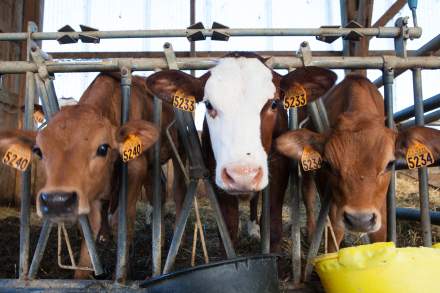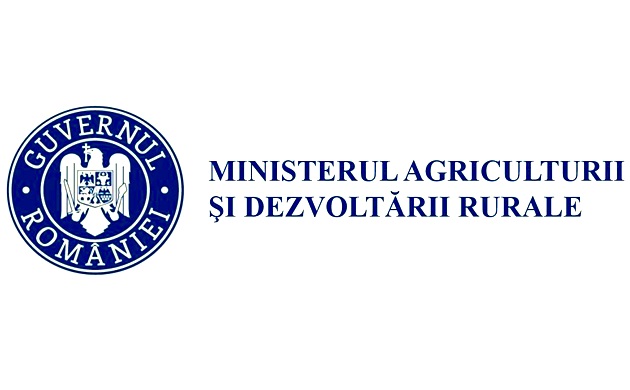346

(Author: Gabriel Nitulescu) Since the middle of last decade, Western European companies from the dairy industry have invested heavily in new EU Member States, playing a vital role in the development of the industry and the profile market from these countries. All companies in the top 10 of the largest European dairy companies now have production facilities in Eastern Europe, playing in the past, now and in the future an important role in the structural development of dairy industry. Eastern Europe, dominated by multinational companies Currently, more than 30 foreign companies from the dairy sector are present in the region, many of them - and here we mention multinationals such as Nestlé, Unilever, Danone and Kraft - operating local processing facilities. Should also be noted that many Western European companies in the field of dairy have built or took over factories in Eastern Europe, among them being Campina, Friesland Foods, Hochland, Ehrmann, Müller, Nordmilch, Meggie, Lactalis , Bel, Bongrain, Euroserum, Valio and Arla Foods. In addition, the area is interesting for the Russian market as well, the largest dairy company, Wimm-Bill-Dann is also active in several markets outside Russia. "At present, foreign companies process most of the milk produced in the region and plays an important role in the sector development, through investments in new technologies, through the innovations achieved, through developing new products and new marketing methods used." shown in a study of 3A Business Consulting company (3ABC) made about year ago. "In addition, vertical integration is a key element where foreign companies, but also local dairy industry invest in improving milk quality and in the cooling and storing milk chains to get high quality products.", stated the same study. Investments made by foreign companies in this field have been favored by a number of factors specific to dairy markets in Eastern Europe that occurred and occur only in those markets or other factors considered compared to those on the Western European markets. Thus, if in the period 2007-2012, the growth of Western Europe was expected to be 10-12%, for Eastern Europe the same indicator was expected to reach double value (20-25%), starting from the lower level. Small competitors purchasing Mature Western European markets was another factor that favored the expansion of Western companies in Eastern European markets. For example, due to the Western European cheese market maturity, the strategic objective of many major players of the field was that of strengthening the position held mainly by acquiring smaller competitors and then by streamlining operations and marketing structure. However, the effects were modest, and the optimization has been achieved at the factory level rather than between companies. Exception is Lactalis, which strengthened leadership position in cheese by purchasing local brands of cheese in Italy, UK, Spain and Central and Eastern Europe. Another factor that influenced the decision of multinationals to enter the Eastern Europe market was the cultural climate. "Unlike other emerging markets, Central and Eastern Europe has important cultural and historical connections with the consumption of dairy products. A simple comparison of per capita consumption between Eastern and Western Europe clearly shows the enormous potential of the region. "shows Tage Affertsholt, Managing Partner at 3A Business Consulting. Specialists indicated that Eastern Europe has many development opportunities, the most tempting being linked to the domestic and regional market potential, to the UHT milk and fresh , to the cheese production demanded on the local market, to the introduction of new products for the local market (drinking yogurt with fruit, for example), to the possibility of local companies acquisition, to the increase of processing capacity, storage and transport, to the possibility of developing new product lines (for the production of goat cheese or feta cheese) or implementation of modern methods of packaging and marketing. Engagement in the primary production Business consultants show that there are opportunities in regional markets and for the companies interested in vertical integration which would like to be involved in primary production, given that the industry is still highly fragmented, with high costs for production, collection and quality control and productivity per animal which is about 50% of the EU average. Moreover, in recent years, as reveals another study of the consulting company GFA Consulting Group, there is taking place a sector restructuring involving a growing number of large multinational companies (eg Meggle, Danone, Lactalis). Although survey data from December 2010, the consulting company GFA Consulting Group works with business figures from 2009, the current situation concerning them is about the same, given that the global financial crisis has limited expansion and investment, even in developing countries that form the South East European region (for example, the Croatian company, Vindija, study provides a turnover of 391 million euros for 2009, and the recent data, from the company website offers a turnover average for the last 3 years of about 400 million, and the situation is repeated with other companies as well). The Balkans, a good milking cow In Serbia, as in Croatia, one of the trends that occur in the food industry is the expansion of holding companies operating in various sectors of the economy. The largest Serbian holding, Delta Holding, which consists of 30 companies operating in different sectors, and also present at the international level in Bosnia-Herzegovina, Montenegro and Bulgaria. The second largest Serbian conglomerate is Victoria Group, present especially in agriculture, chemicals and financial services. Besides these local conglomerates, is worth mentioning the presence of some international companies. Danube Foods Group (DFG) for example, part of the English investment fund, Salford operates mainly in the food industry in Serbia and in the region. DFG has 15 dairy plants, including the two largest Serbian dairy factories (Imlek and Suboticka Mlekara), with a 47.4% sector market share with a turnover of over 300 million euros in 2009. Sabacka Mlekara (46 million euros turnover in 2009) is the only company in the dairy sector ranked in the top five, held by Serbian shareholders (Farmakom MB Concern). Somboled, the dairy factory in Sombor (36 million euros in 2009), with a market share of 5.4% was acquired by dairy Croatian company, Dukat, owned by French company Lactalis Group. On the Serbian profile market is present another dairy French company, Bongrain, which owns local company Mlekoprodukt Zrenjanin (9 million euros in 2009) with a market share of 3.9%. In Croatia, in the dairy industry there are 37 dairies, where the biggest two (Dukat and Vindija) processes more than two thirds of the total processed milk. Dukat (turnover in 2009 of 245 million euros) and Vindija (turnover in 2009 of 391 million euros) have been growing in turnover in recent years and have become major regional players with exports increasing and acquisitions of companies in neighboring countries. Amongst medium-sized factories in terms of turnover (about 40 million euros) stands Meggle. Croatian milk production reached 814 million liters in 2009, up by 65% since 2000. However, Croatia is still a net importer of dairy products, especially cheese, milk and fermented milk. In Bosnia-Herzegovina are about 100 dairies with a total production capacity of about 2 million liters of milk / day, of which only one third is used. About 45 dairies exceed the capacity of 1,000 liters / day and 10 exceed the capacity of 100,000 liters / day. In general, these factories produce goods with low added value, but with quick sale and only a few product range such as ripened cheese varieties have higher added value. As a result, many high value-added dairy products are imported from neighboring countries or from the EU. The market leader is the brand of dairy products, Kozarska Dubica (Mlijeko) of Mlekara Kozarksa Dubica (DFG) (approximately 31 million euros turnover in 2009), followed by Meggle Eastern Europe (the German company Meggle), (about 20 million euros turnover in 2009), Sarajevska Milk (Teloptic) of Milkos (about 9 million euros turnover in 2009). Companies meet HACCP and ISO quality standards, and some are certified for the Halal production. In 2008, three dairies in Bosnia - Banja Luka, EASTMILK and Mlijekoprodukt - began operational integration with the Imlek Serbian group (the DFG, Salford Capital). In Albania, the milk processing industry is still being in the process of modernization and refurbishment. The value added tax of 20% for all processed dairy products is considered a major obstacle to industrial development, given that only processed products are subject to this levy, farmers being exempted from paying this tax. This creates a significant difference in the price between the processed products market and the informal market. On the Albanian dairy market exists about 27 modern milk processing plants each with a processing capacity of between 10 and 40 tons / day (none of which operate at full power). Albania's largest milk processing company is Mireli. Meggle is currently the only foreign company operating in the field of milk processing on the Albanian market, Meggie Eastern Europe Ltd. officially became since August 2010, the sole shareholder of Ferla sh.pk, based in Rhogozine, one of the largest dairies in Albania. Other large dairy factories are Greal in Korca, Mireli in Kavaja, Deltadoni in Lushnja and Gjirofarma in Gjirokastra. In Kosovo, the local milk production stands at about 240 to 260,000 tons / year. Milk is generally consumed straight from the farm gate or from the local market. Only 10-15% of the milk produced is sent to processing (about 34,000 tons). Imports totaled about 82,000 tons per year (25-30 million euros annually) and are mainly UHT milk, yogurt, butter, white cheese (feta) and yellow cheese. About 80% of these imports come from Hungary, Slovenia and Germany. Kosovo has about 26 processing units of which 18 are authorized, and only 5-6 of them can be called commercial (with an output of 5,000-40,000 liters per day). The main products are drinking milk, yogurt and white cheese. In 2003, Devolli company, Peja, started production of UHT milk Vita, which is the result of cooperation between Devolli and Tetra Pak. Dairy company Abi (Abi supermarket group component) processes about 20,000 liters of milk. Another company in the process of development is Bylmeti In FYR Macedonia, there are about 85 dairies, mostly small or medium size and are mostly owned by foreign companies (mainly from Serbia and Croatia). Market leaders are Mlekara Bitola AD-IMB (Imlek Serbia / DFG) with the brand Bimilk (about 29 million euros turnover in 2009), Ideal Sipka a.d. from Bitola (about 13 million euros turnover) owned by Dukat/Lactalis and Zdravje Radovo from Kumanovo (about 11 million euros turnover in 2009). Other companies in the field are Beka Company Eko Shar, Bucen Kozjak (Imlek / DFG), Rudin, Laktis, and Dairy Stip. Annual production of milk in Macedonia is about 200 million liters per year. Montenegro with a population of approximately 600,000 inhabitants is a small market, with an annual production of about 160,000 tons of milk. Only 15-20% of the total quantity of milk produced is processed. There is none foreign investor in the local dairy industry. One Italian company started production of mozzarella with a Montenegrin partner, but meanwhile this has sold its shares and exit the market. In recent years, the Montenegrin dairy sector has faced major problems due to unclear status in relation with Serbia, country which massively subsidize its agro-industrial sector. The largest processors of the Bulgarian dairy industry are two firms owned by foreign investors: Obedinenie Mlechna Kompania (owned by Greek company Vivartia) with a market share of 19% and Danone Serdika AD with a market share of 12%. Another important foreign investment in this field is the acquisition by GED Capital Development of the dairy plant in Dobrich (northeastern Bulgaria). The rest of the market is divided between companies that have a market share of 5%, most of which are owned by local shareholders. As a comparison, the largest Bulgarian company processes a quantity of milk of about five times smaller than the largest Romanian company in this field. On the yoghurt market, Danone Serdika is the market leader with a share of about 40%. Apparently, Bulgaria is an attractive market for Greek firms in the dairy sector, due to geographic proximity and to the EU milk quota allocated to Bulgaria. French company, Lactalis recently expressed its interest in the dairy Bulgarian market.



